check engine TOYOTA 86 2019 Owner's Manual
[x] Cancel search | Manufacturer: TOYOTA, Model Year: 2019, Model line: 86, Model: TOYOTA 86 2019Pages: 532, PDF Size: 6.89 MB
Page 171 of 532
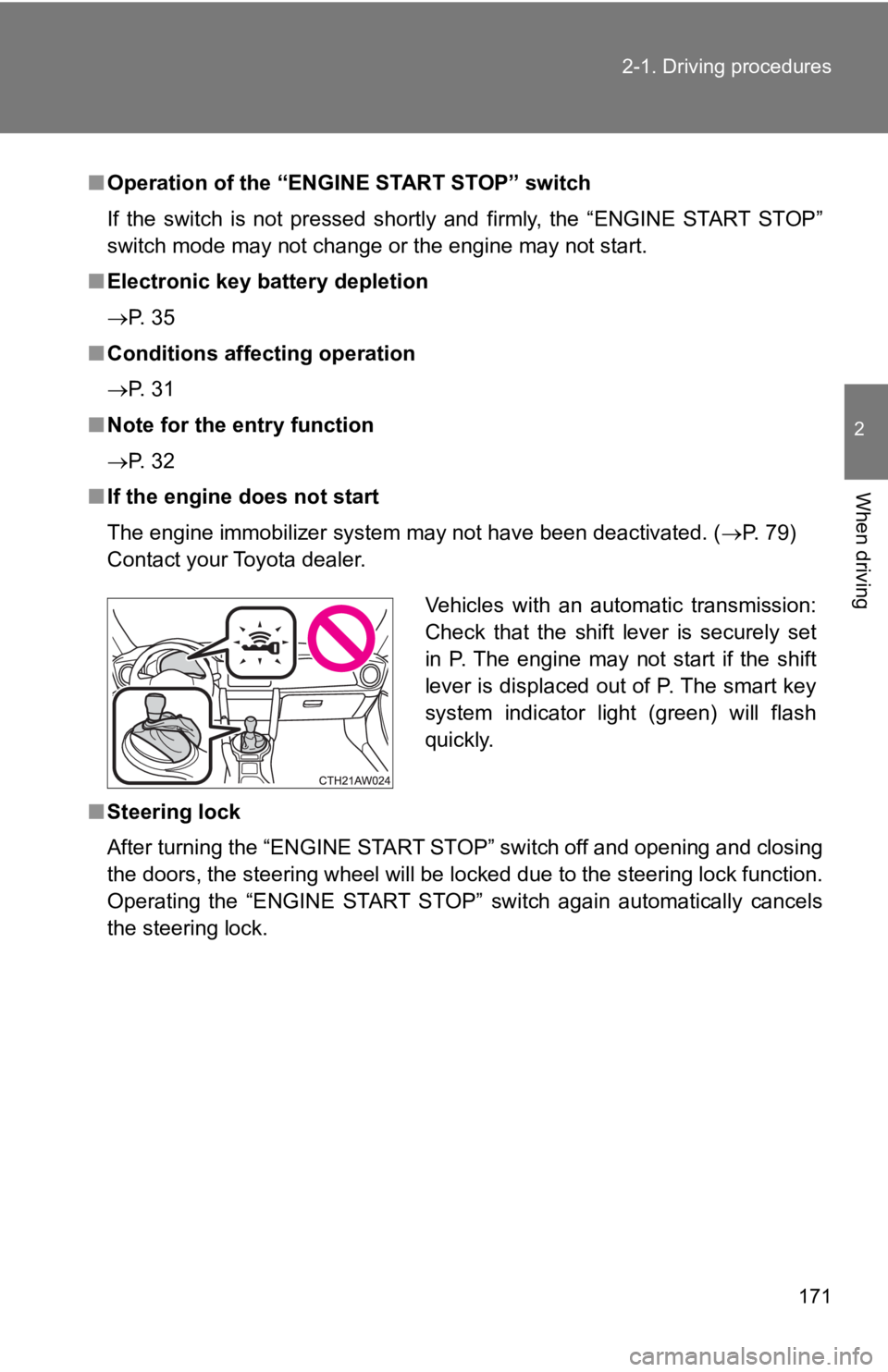
1712-1. Driving procedures
2
When driving ■ Operation of the “EN GINE START STOP” switch
If the switch is not pressed shortly and firmly, the “ENGINE ST ART STOP”
switch mode may not change or the engine may not start.
■ Electronic key battery depletion
P. 35
■ Conditions affecting operation
P. 31
■ Note for the entry function
P. 32
■ If the engine does not start
The engine immobilizer system may not have been deactivated. ( P. 79)
Contact your Toyota dealer.
■ Steering lock
After turning the “ENGINE START STOP” switch off and opening an d closing
the doors, the steering wheel will be locked due to the steerin g lock function.
Operating the “ENGINE START STOP” switch again automatically cancels
the steering lock. Vehicles with an automatic transmission:
Check that the shift lever is securely set
in P. The engine may not start if the shift
lever is displaced out of P. The smart key
system indicator light (green) will flash
quickly.
Page 172 of 532
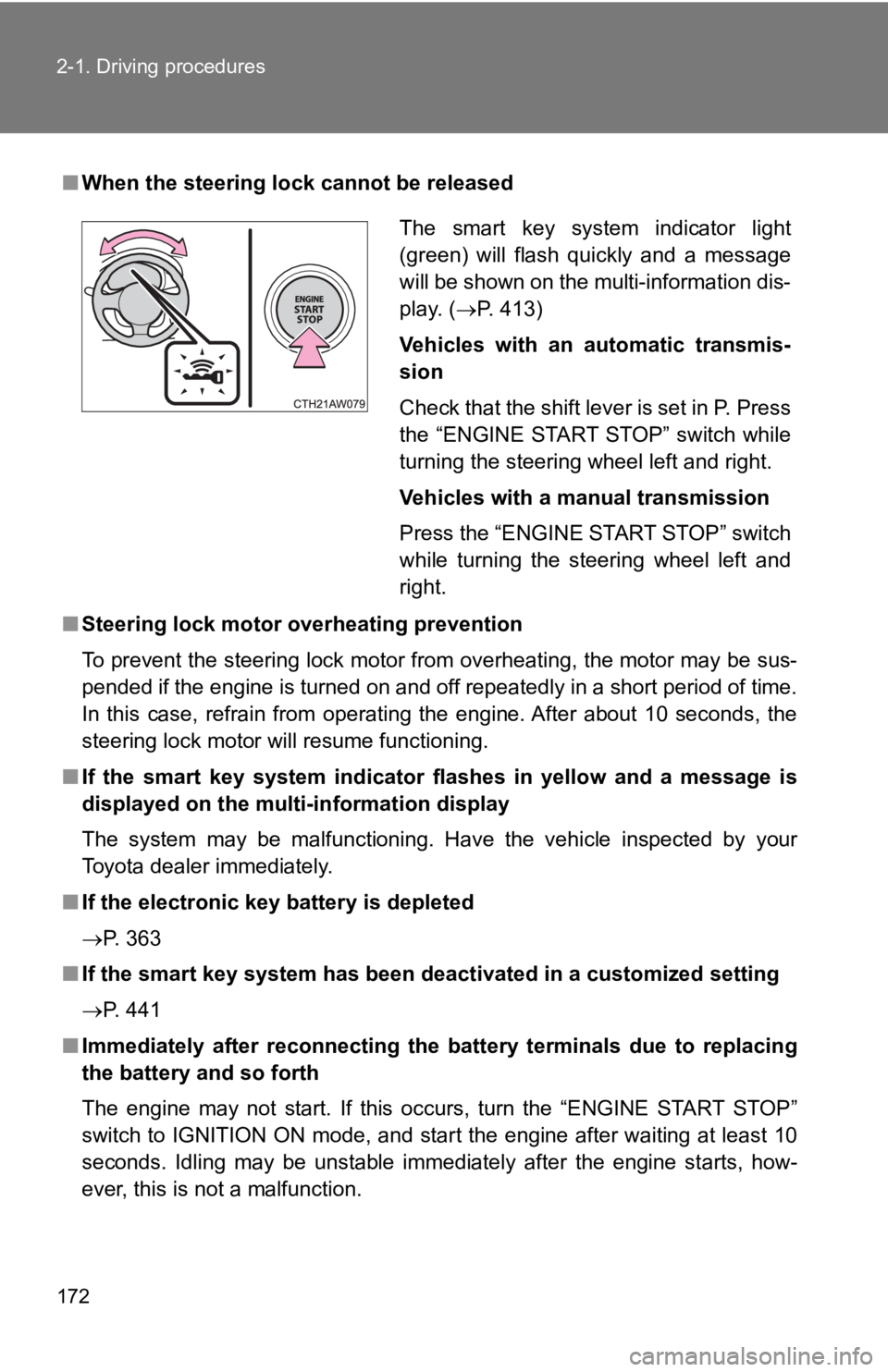
1722-1. Driving procedures
■ When the steering lock cannot be released
■ Steering lock motor o verheating prevention
To prevent the steering lock motor from overheating, the motor may be sus-
pended if the engine is turned on and off repeatedly in a short period of time.
In this case, refrain from operating the engine. After about 10 seconds, the
steering lock motor will resume functioning.
■ If the smart key system indicator flashes in yellow and a messa ge is
displayed on the multi-information display
The system may be malfunctioning. Have the vehicle inspected by your
Toyota dealer immediately.
■ If the electronic key battery is depleted
P. 363
■ If the smart key system has been deactivated in a customized se tting
P. 441
■ Immediately after reconnecting th e battery terminals due to rep lacing
the battery and so forth
The engine may not start. If this occurs, turn the “ENGINE STAR T STOP”
switch to IGNITION ON mode, and start the engine after waiting at least 10
seconds. Idling may be unstable immediately after the engine st arts, how-
ever, this is not a malfunction. The smart key system indicator light
(green) will flash quickly and a message
will be shown on the multi-information dis-
play. ( P. 413)
Vehicles with an automatic transmis-
sion
Check that the shift lever is set in P. Press
the “ENGINE START STOP” switch while
turning the steering wheel left and right.
Vehicles with a manual transmission
Press the “ENGINE START STOP” switch
while turning the steering wheel left and
right.
Page 174 of 532

1742-1. Driving procedures
NOTICE■ To prevent battery discharge
● Do not leave the “ENGINE START STOP” switch in ACCESSORY or IGN I-
TION ON mode for long periods of time without the engine runnin g.
● If the smart key system indicator light (green) is illuminated, the “ENGINE
START STOP” switch is not off. When exiting the vehicle, always check
that the “ENGINE START STOP” switch is off.
● Vehicles with an automatic transmission: Do not stop the engine when the
shift lever is in a position other than P. If the engine is sto pped in another
shift lever position, the “ENGINE START STOP” switch will not b e turned
off but instead be turned to ACCESSORY mode. If the vehicle is left in
ACCESSORY mode, battery discharge may occur.
■ When starting the engine
● Do not race a cold engine.
● If the engine becomes difficult to start or stalls frequently, have your vehi-
cle checked by your Toyota dealer immediately.
● Vehicles with an automatic transmission: Do not shift the shift lever while
the starter is operating.
■ Symptoms indicating a malfunction with the “ENGINE START STOP”
switch
If the “ENGINE START STOP” switch seems to be operating somewha t dif-
ferently than usual, such as the switch sticking slightly, there may be a mal-
function. Contact your Toyota dealer immediately.
Page 175 of 532
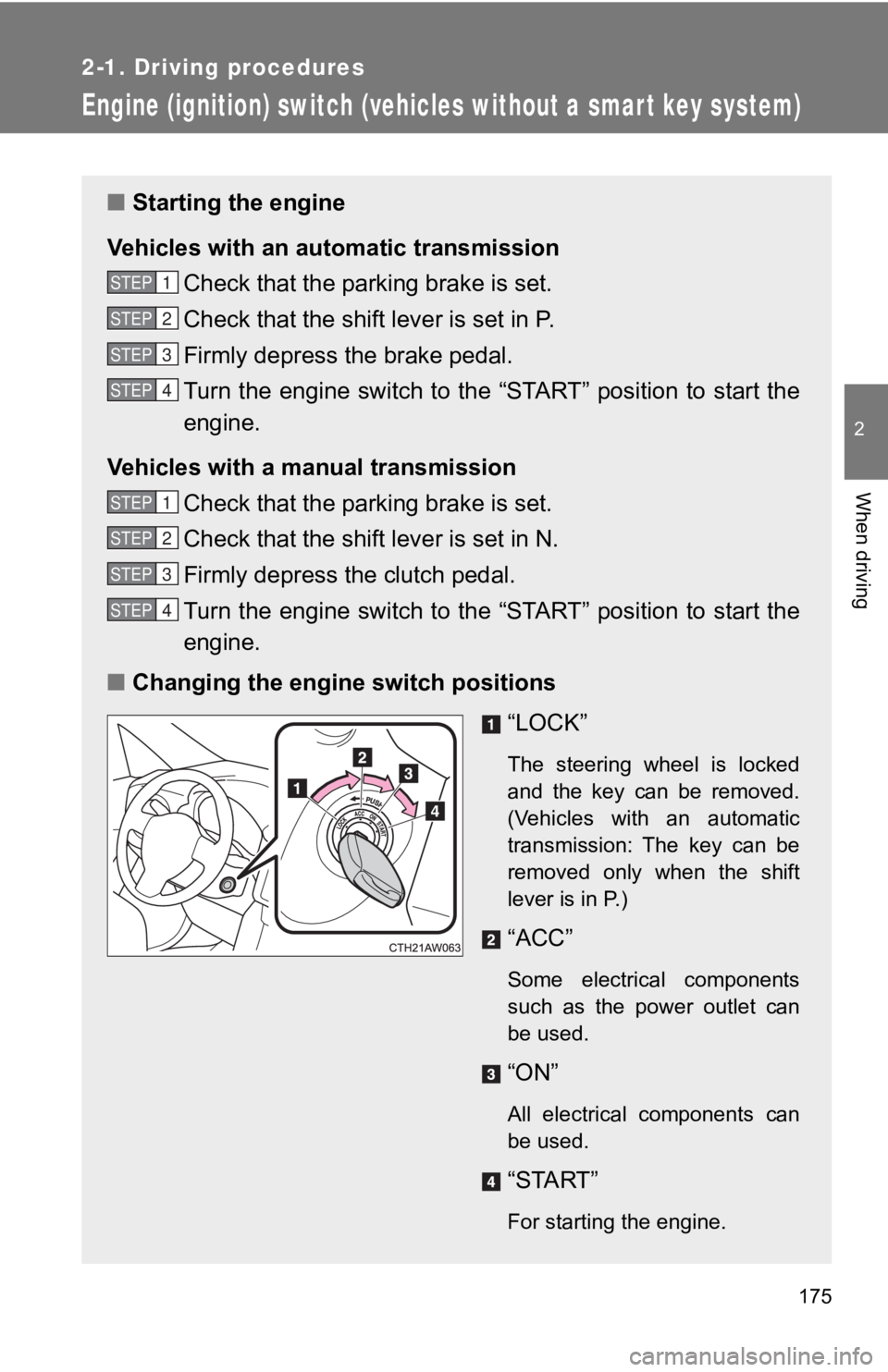
1752-1. Driving procedures
2
When driving
Engine (ignition) switch (vehicles without a smart key system) ■ Starting the engine
Vehicles with an auto matic transmission
Check that the parking brake is set.
Check that the shift lever is set in P.
Firmly depress the brake pedal.
Turn the engine switch to the “START” position to start the
engine.
Vehicles with a manual transmission
Check that the parking brake is set.
Check that the shift lever is set in N.
Firmly depress the clutch pedal.
Turn the engine switch to the “START” position to start the
engine.
■ Changing the engine switch positions
“LOCK” The steering wheel is locked
and the key can be removed.
(Vehicles with an automatic
transmission: The key can be
removed only when the shift
lever is in P.)
“ACC” Some electrical components
such as the power outlet can
be used.
“ON”
All electrical components can
be used.
“START”
For starting the engine.STEP 1
STEP 2
STEP 3
STEP 4
STEP 1
STEP 2
STEP 3
STEP 4
Page 177 of 532

1772-1. Driving procedures
2
When driving WARNING■ When starting the engine
Always start the engine while sitting in the driver's seat. Do not depress the
accelerator pedal while starting the engine under any circumsta nces.
Doing so may cause an accident resulting in death or serious in jury.
■ Caution when driving
Do not turn the engine switch to the “LOCK” position while driving. If, in an
emergency, you must turn the engine off while the vehicle is mo ving, turn the
engine switch only to the “ACC” position to stop the engine. An accident may
result if the engine is stopped while driving. ( P. 454)
NOTICE■ To prevent battery discharge
Do not leave the engine switch in the “ACC” or “ON” position fo r long periods
of time without the engine running.
■ When starting the engine
● Do not crank the engine for more than 10 seconds at a time. This may
overheat the starter and wiring system.
If the engine does not start, turn the engine switch to the “LOCK” position
and try to start the engine again after waiting for 10 seconds or more.
● Do not race a cold engine.
● If the engine becomes difficult to start or stalls frequently, have your vehi-
cle checked by your Toyota dealer immediately.
● Vehicles with an automatic transmission: Do not shift the shift lever while
the starter is operating.
Page 188 of 532
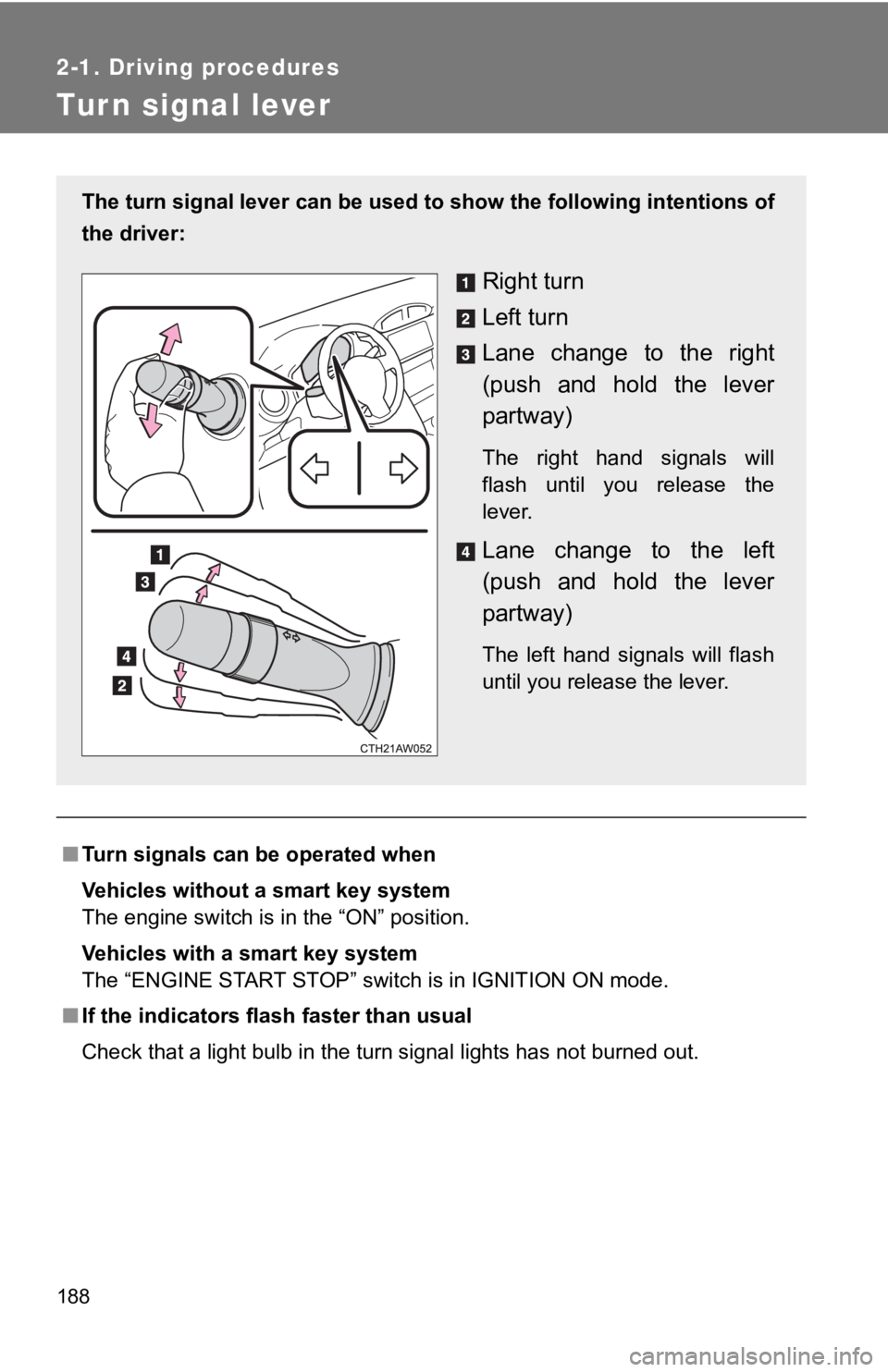
1882-1. Driving procedures
Tur n signal lever
■ Turn signals can be operated when
Vehicles without a smart key system
The engine switch is in the “ON” position.
Vehicles with a smart key system
The “ENGINE START STOP” switch is in IGNITION ON mode.
■ If the indicators flash faster than usual
Check that a light bulb in the turn signal lights has not burne d out.The turn signal lever can be used to show the following intenti ons of
the driver:
Right turn
Left turn
Lane change to the right
(push and hold the lever
partway) The right hand signals will
flash until you release the
lever.
Lane change to the left
(push and hold the lever
partway) The left hand signals will flash
until you release the lever.
Page 193 of 532

1932-2. Instrument cluster
2
When driving ■ The meters and display illuminate when
Vehicles without a smart key system
The engine switch is in the “ON” position.
Vehicles with a smart key system
The “ENGINE START STOP” switch is in IGNITION ON mode.
■ The brightness of the i nstrument panel lights
When the parking lights or the headlights turn on, the instrume nt panel lights
will dim. However, when the instrument panel brightness control dial is
turned to the up most position, the instrument panel lights wil l not dim even
when the parking lights or headlights turn on.
NOTICE■ To prevent damage to the engine and its components
● Do not let the indicator needle of the tachometer enter the red zone, which
indicates the maximum engine speed.
● In the following situations, the engine may be overheating. In this case,
immediately stop the vehicle in a safe place, and check the eng ine after it
has cooled completely. (
P. 449)
• Vehicles with a monochrome multi-information display: The engi ne
coolant temperature gauge enters the red zone
• Vehicles with a color multi-information display: The high engine coolant
temperature warning light flashes or illuminates
Page 197 of 532
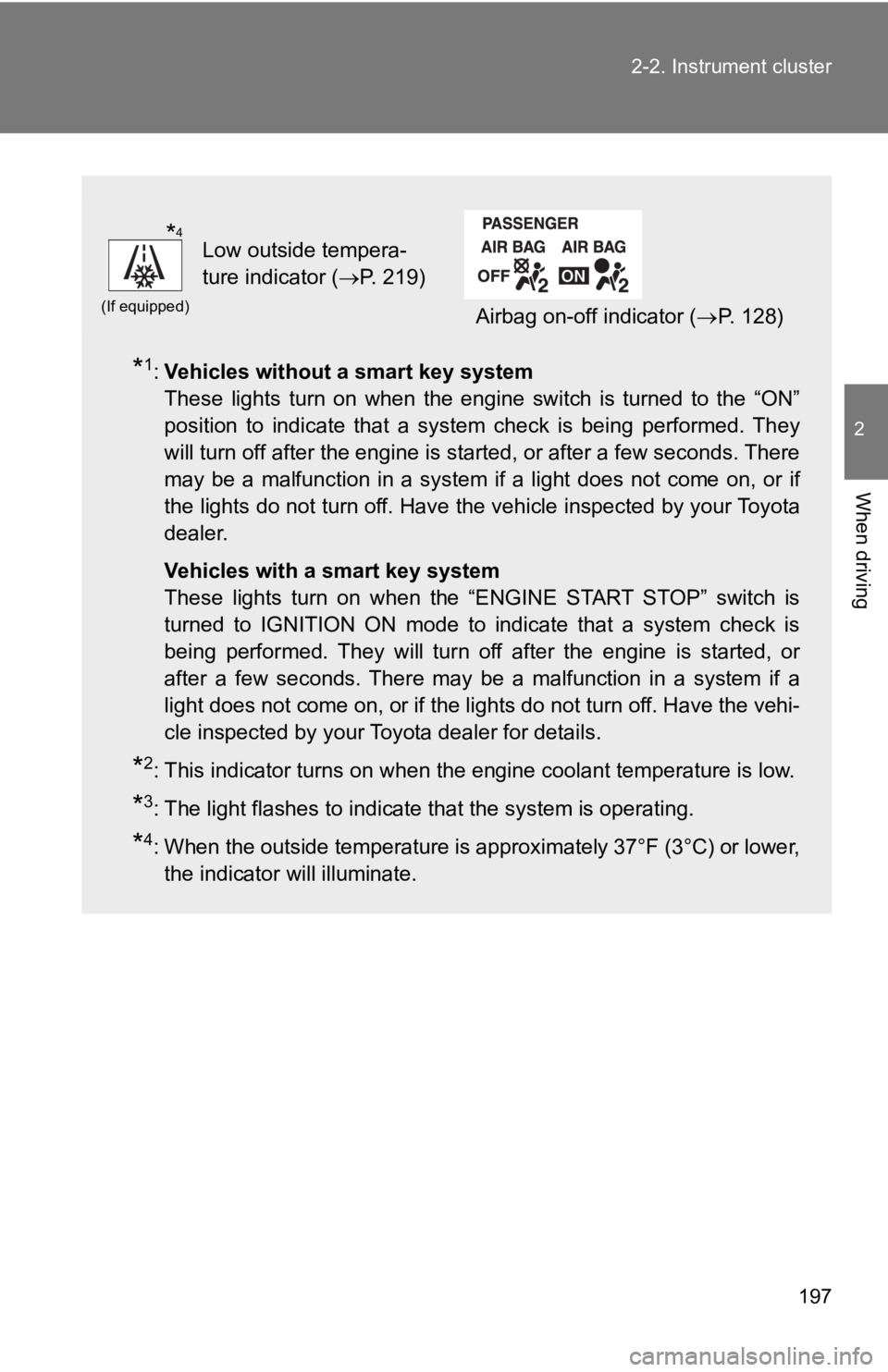
1972-2. Instrument cluster
2
When driving
* 1
: Vehicles without a smart key system
These lights turn on when the engine switch is turned to the “O N”
position to indicate that a system check is being performed. Th ey
will turn off after the engine is started, or after a few secon ds. There
may be a malfunction in a system if a light does not come on, o r if
the lights do not turn off. Have the vehicle inspected by your To y o t a
dealer.
Vehicles with a smart key system
These lights turn on when the “ENGINE START STOP” switch is
turned to IGNITION ON mode to indicate that a system check is
being performed. They will turn off after the engine is started , or
after a few seconds. There may be a malfunction in a system if a
light does not come on, or if the lights do not turn off. Have the vehi-
cle inspected by your Toyota dealer for details.
* 2
: This indicator turns on when the engine coolant temperature is low.
* 3
: The light flashes to indicate that the system is operating.
* 4
: When the outside temperature is approximately 37°F (3°C) or lo wer,
the indicator will illuminate.(If equipped)
Low outside tempera-
ture indicator ( P. 219)
Airbag on-off indicator ( P. 128)
* 4
Page 198 of 532
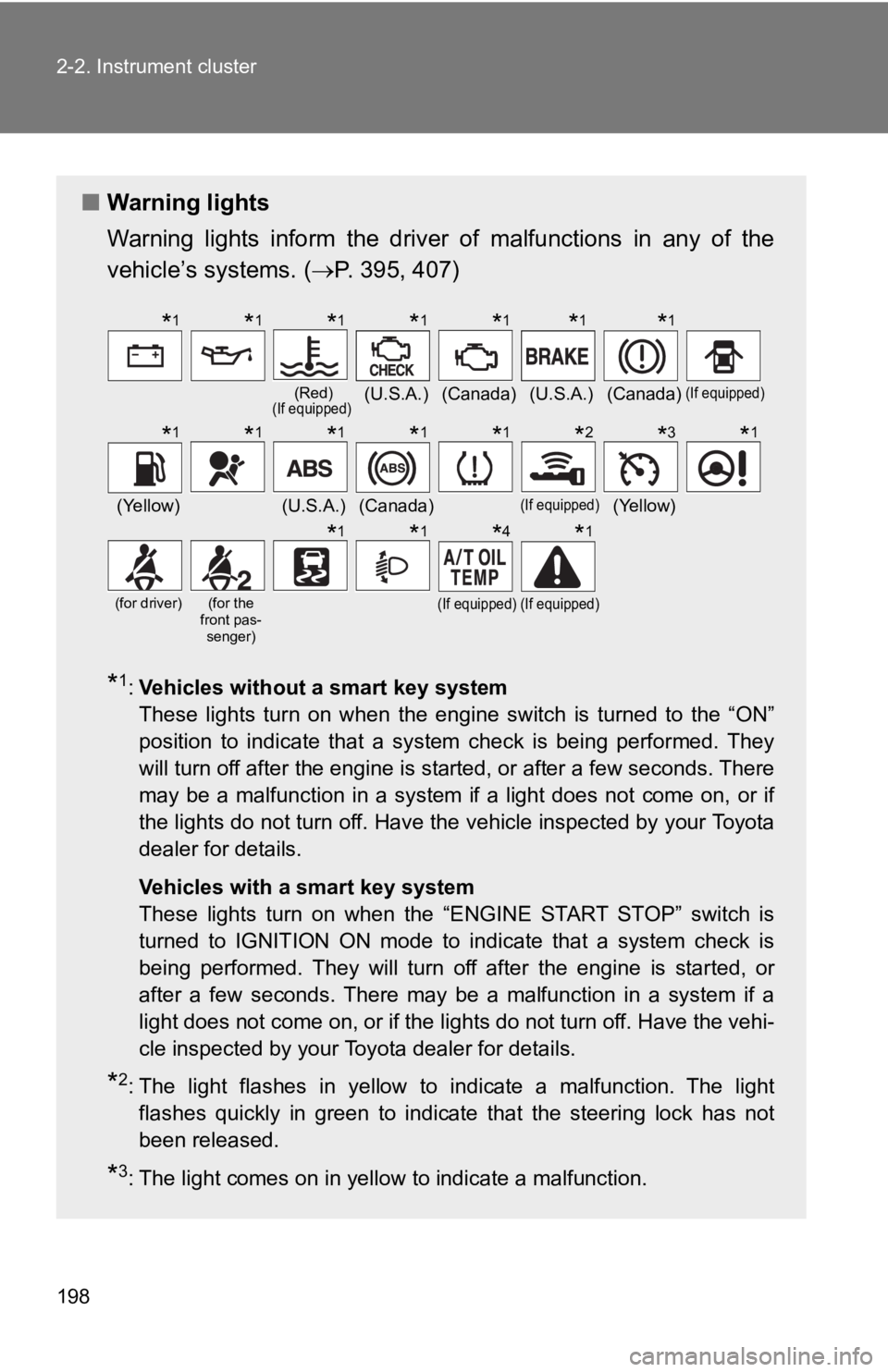
1982-2. Instrument cluster
■ Warning lights
Warning lights inform the driver of malfunctions in any of the
vehicle’s systems. ( P. 395, 407)
* 1
: Vehicles without a smart key system
These lights turn on when the engine switch is turned to the “O N”
position to indicate that a system check is being performed. Th ey
will turn off after the engine is started, or after a few secon ds. There
may be a malfunction in a system if a light does not come on, o r if
the lights do not turn off. Have the vehicle inspected by your To y o t a
dealer for details.
Vehicles with a smart key system
These lights turn on when the “ENGINE START STOP” switch is
turned to IGNITION ON mode to indicate that a system check is
being performed. They will turn off after the engine is started , or
after a few seconds. There may be a malfunction in a system if a
light does not come on, or if the lights do not turn off. Have the vehi-
cle inspected by your Toyota dealer for details.
* 2
: The light flashes in yellow to indicate a malfunction. The light
flashes quickly in green to indicate that the steering lock has not
been released.
* 3
: The light comes on in yellow to indicate a malfunction. (Red)
(If equipped)
(U.S.A.) (Canada) (U.S.A.) (Canada) (If equipped)
(Yellow) (U.S.A.) (Canada) (If equipped)
(Yellow)(for driver) (for the
front pas-
senger)
(If equipped) (If equipped)
* 1
* 1
* 1
* 1
* 1
* 1
* 1
* 1
* 1
* 1
* 1
* 1
* 2
* 3
* 1
* 1
* 1
* 4
* 1
Page 199 of 532
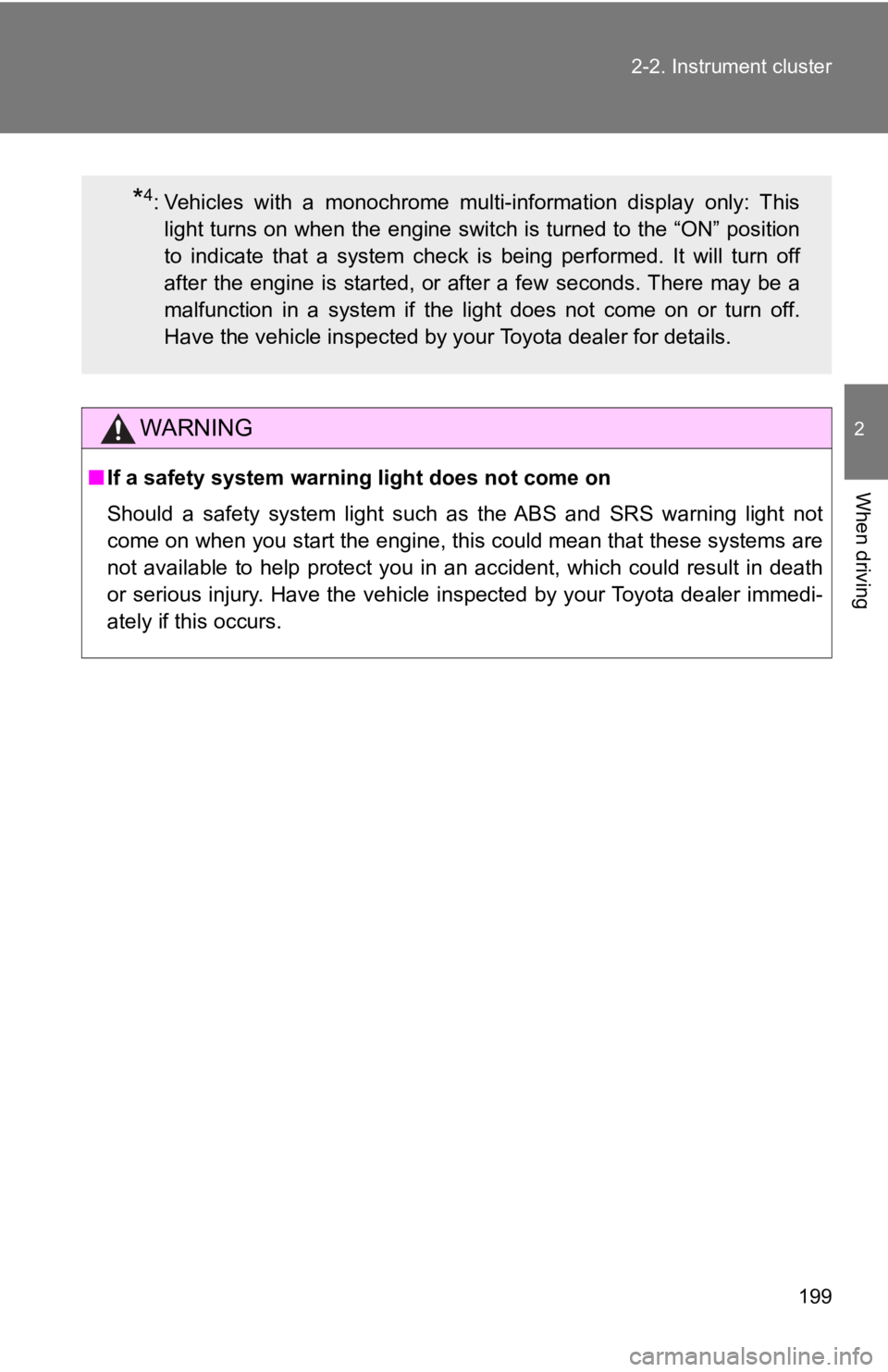
1992-2. Instrument cluster
2
When driving
WARNING■ If a safety system warning light does not come on
Should a safety system light such as the ABS and SRS warning li ght not
come on when you start the engine, this could mean that these s ystems are
not available to help protect you in an accident, which could r esult in death
or serious injury. Have the vehicle inspected by your Toyota de aler immedi-
ately if this occurs.* 4
: Vehicles with a monochrome multi-information display only: Thi s
light turns on when the engine switch is turned to the “ON” pos ition
to indicate that a system check is being performed. It will tur n off
after the engine is started, or after a few seconds. There may be a
malfunction in a system if the light does not come on or turn o ff.
Have the vehicle inspected by your Toyota dealer for details.